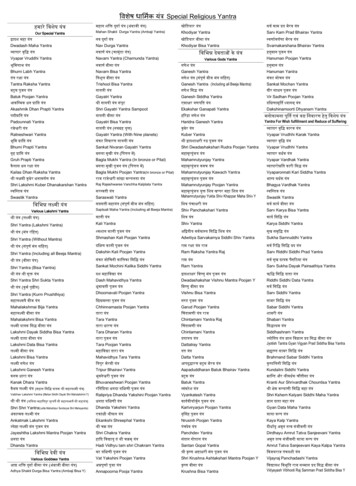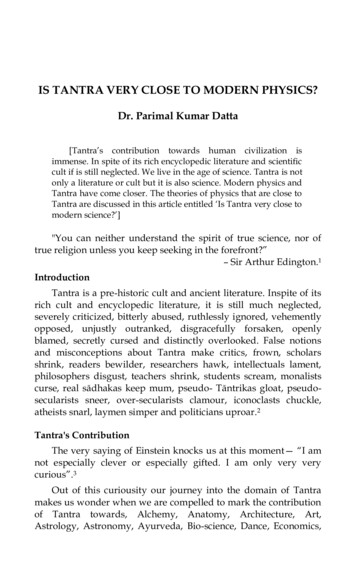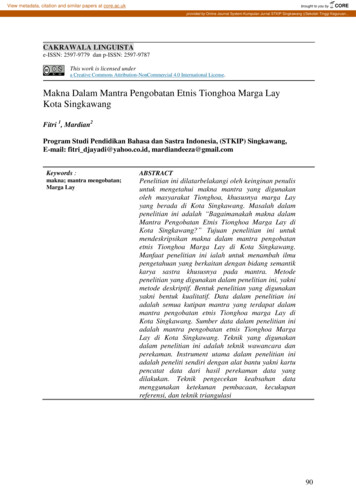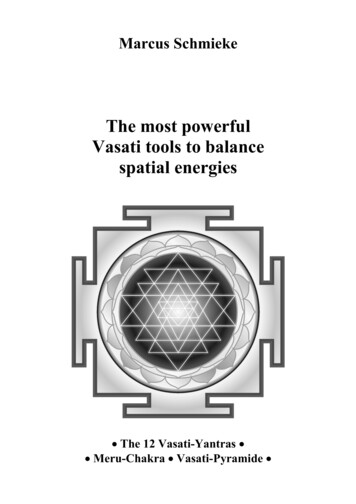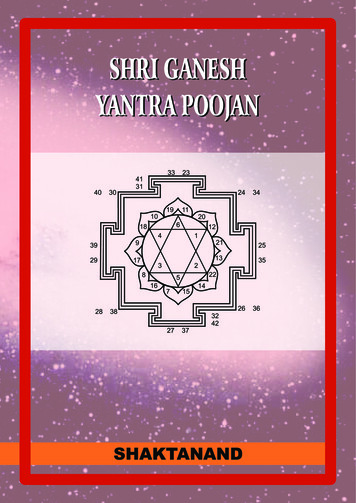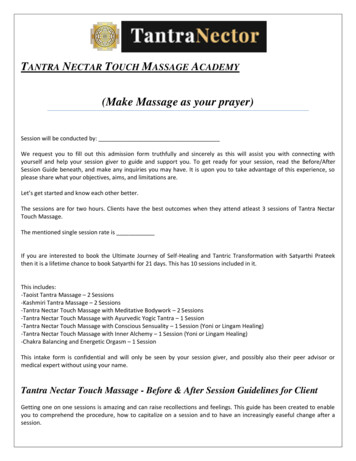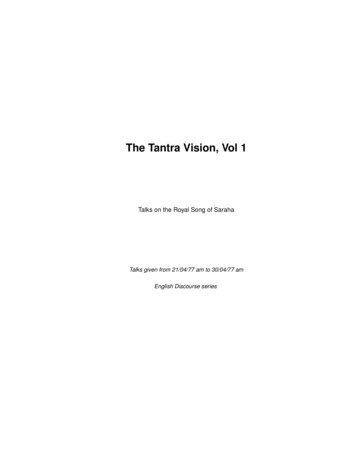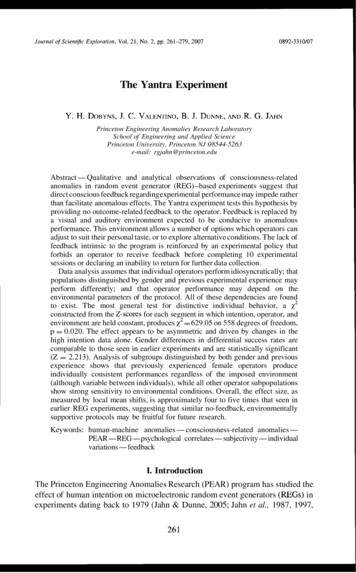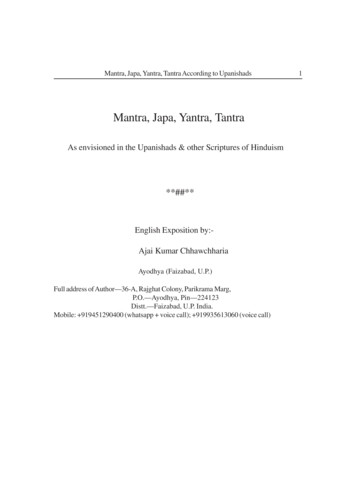
Transcription
Mantra, Japa, Yantra, Tantra According to UpanishadsMantra, Japa, Yantra, TantraAs envisioned in the Upanishads & other Scriptures of Hinduism**##**English Exposition by:Ajai Kumar ChhawchhariaAyodhya (Faizabad, U.P.)Full address of Author—36-A, Rajghat Colony, Parikrama Marg,P.O.—Ayodhya, Pin—224123Distt.—Faizabad, U.P. India.Mobile: 919451290400 (whatsapp voice call); 919935613060 (voice call)1
2Mantra, Japa, Yantra, Tantra According to UpanishadsContents1. Mantra: Page 32. Japa: Page 763. Yantra: Page 784. Tantra: Page 805. About the Author: Page 856. Sketch of 2 Yantras: Page 89-907. Dedication: Page 91
Mantra, Japa, Yantra, Tantra According to Upanishads3Mantra, Japa, Yantra and TantraMantra:While going through the Upanishads and other scriptural Texts of Hinduism, wecome across the word 'Mantra' repeatedly. What are they? In a lay-man’s language, aswe have seen, Mantras are either a single letter, a syllable or a group of letters or syllablesforming a word, a group of words, even a phrase or a short statement— which we cancall a ‘spiritual formulae’. They are a unique and potentially uplifting, energy-chargedthought currents. These currents are transformed into words to make them useable andaccessible. For the purpose of God-realisation (or realisation of the supreme Brahm),these Mantras are used in meditation repeatedly to help concentrate the mind. These arecalled Mantras because by proper contemplation on their import, they are able to removethe inner obstacles and facilitate realisation. They are catalysts or mediums for realisation.They help in reaching of the supreme Advaitic ideal of identifying the Atma with the Brahm,the individual self with the universal Self. The Mantras are the vehicles used during Japa(repetition of the holy name of the Lord) also.The Atharva Veda’s Hayagriva Upanishad, verse nos. 18-19 tell us how the Mantrasshould be repeated during Japa, and the importance of the Mantras in helping the spiritualaspirant reach the ecstasy of spiritual realisation by citing the example of the snake and thesound of the Indian lute.“verse no. 18 The Mantras should be pronounced clearly by employing the lips, thenose, the teeth, etc. [This is because some class of letters are pronounced by the involvementof the lips, such as Sanskrit letters ‘Pa’ (as in pump), ‘Pha’ (as in fruit), ‘Ba’ (as in bulb) etc.;others require the involvement of the nose, such as the letters ‘Na’ (as in nut), or the teeth, asin the case of the letter ‘Da’ (as in then), or the tongue as in the case of the other letters such as‘Ta’ (as in two, teeth) and ‘Cha’ (as in choke) etc.]The Mantras should be said continuously, in an unbroken stream of words and lettersso that they appear to be like a wheel in motion. The worshipper should offer his prayers toIshan (the Lord, the Supreme Being) in this way.[It ought to be noted here that while verse nos. 16-17 emphasis that the Gods offertheir prayers to the Supreme Being in a series of sounds, viz. like the neighing of a horse, theman is supposed to offer the same prayer of the Vedas in articulate language. This is the caseif he is not an expert in classical forms of music so that he can sing the hymns in the typical waythe Gods had sung them. So such a worshipper articulately pronounces the words of thehymns. But the continuous pronouncing gives the Mantra a subtle hue of music because of therhythm and tone involved in the incantation.‘Ishan’ means an emblem (‘Nishan’) of the Lord (‘Isha’). The implication is simple—when a worshipper offers prayers or obeisance to Lord Hayagriva or even his own Atma, he
4Mantra, Japa, Yantra, Tantra According to Upanishadsis actually honouring the Supreme Being known as ‘Brahm’. All other forms and deities towhom worship is offered are actually emblems of Brahm; they stand for Brahm.] (18).“verse no. 19 The creator and controller of this creation has established this greatsystem of Mantras. He has enabled even the serpent to understand the language of music as isevident from the fact that by playing the Indian lute the serpent can be controlled as it iscompletely overwhelmed and enthralled by its music.[The music emanating from the lute has no words, but it is sufficient to enchant theserpent. The serpent understands the music and gets so ecstatic that if the lute is played expertlyit would raise its hood and sway from side to side in joy. The same music will mean nothing tothe man or any other animal. It is believed that it is very easy to control even the most ferocioussnake with the help of certain Mantras when they accompany the playing of the lute.The snake actually does not understand what song is being played on the lute, but thefrequencies generated by sound of this instrument are sufficient to massage its nerves to suchan extent that the sense of ecstasy and exhilaration is aroused in the reptile.The idea being conveyed here is that though one may not know the meaning of theMantras fully, though he may not be an expert in the science of Mantras, or know the intricaciesof metaphysics and spiritualism, but still if he repeats some given set of Mantras they are boundto produce their positive effects upon him even though he may be unaware of them, or he maybe enjoying these benefits unwittingly.There is one other significance of citing the case of the Indian lute vis-à-vis the serpent.The serpent is made ecstatic only by the sound or the music of this instrument, and it pays noheed to any other musical instrument. Therefore, if one were to attain Brahm and understandthe potentials of his Atma, he must use the correct Mantra and follow the correct path asenvisaged by the Upanishads. Wrong Mantra repeated wrongly will produce no effects likethe serpent is not aroused by any other musical instrument except the Indian lute.]This ‘wheel’ represented by the continuous chanting or singing of the Mantras isrepresented by the symbolic halo around the Sun that consists of its brilliant rays, and aroundthe Gods that represent their divinity and holiness. [In other words, if the Mantras are incantedproperly in the prescribed manner, the person also develops a halo of holiness around himself.](19).Atharva Veda’s Ram Purva Tapini Upanishad, Canto 1, verse nos. 12-13 describethe concept of ‘Mantra’ elaborately. Let us see how this concept is explained by this Upanishadin the context of the Mantras of Lord Ram—“Verse no. 12 Whatever deeds and actions an aspirant or seeker does or undertakesto do to achieve his goal are successful through the medium of a Mantra. The Mantra is amedium by which desired results are easily and comfortably attained; they are aids to one’sfulfillment of desires and objectives in life—whether mundane or spiritual1. A Mantra makesthe attainment of the desired goal a certainty.A Mantra indicates the result or rewards that can be expected by using it just like acertain ingredient in a medicine can indicate in advance what one can expect by the use of that
Mantra, Japa, Yantra, Tantra According to Upanishads5particular formulation. [This is because each Mantra is like a mathematical formula, and eachhymn is like an equation. Even as definitive results follow the use of certain pre-determinedformula and equation in scientific quest or mathematical calculations, definitive results are alsoexpected by employing specific Mantras for doing Japa (repetition) or Yoga (meditation) andDhyan (contemplation) with specific objectives in mind.]The word Mantra is derived from two words—the first word is ‘Manan’ which meansto persistently remember something so as to make the mind firmly rooted in it, to ponder andcontemplate upon it, to deeply think about it and meditate on it so that one can arrive at somecertain conclusion about the truth of that particular thing, while the second word ‘Traan’ meansto give freedom and protection from some kind of torment or miserable condition, to deliversomeone from his miseries and predicaments etc. Hence, a Mantra is an instrument by the helpof which a person can find spiritual liberation and deliverance from his worldly torments andmiseries. This is achieved by concentrating upon the Mantra, by relying upon its mystical powersand spiritual potentials, and using it to do meditation and contemplation. Constant repetition ofthe Mantra helps to multiply its effect and reinforce its earlier benefits. [Repetition of the Mantrais necessary for its full benefits to accrue and take effect. It’s just like the case of a patienthaving to repeat a medicine over a long period of time to get rid of some chronic disease. If hestops taking it before the disease is completely routed, then not only would the disease relapsebut it would do so with a vengeance. Another example can be cited about a man’s skills andexpertise in a professional field—if he discontinues using his knowledge and skills after sometime in life, he forgets about them and gets out of tune. All the long years he had spent acquiringthe knowledge and the special skill go to a waste if they are not practiced for a lifetime.Similarly, repetition of Mantras and practice of meditation is a life-long process, and a wiseman should persevere with them.] (12).[Note—1In the present case, this Mantra that is employed for doing Japa is the ‘RamMantra’ which is a Tarak Mantra (refer Ram Uttar Tapini Upanishad, Canto 2, verseno. 1). This indicates that the aspirant seeks his final spiritual liberation and deliverancerather than hoping to get some worldly gain by employing it. Being a ‘Tarak Mantra’instead of an ordinary Mantra, this Mantra of Lord Ram is the one that liberates theperson from all spiritual delusions and worldly snares, and therefore to use it for someworldly accomplishments or gains would be absolutely absurd and ridiculous.Again, since the Mantra of Lord Ram pertains to the cosmic Divinity known as thesupreme transcendental Brahm which is pure Consciousness and the Absolute Truth ofcreation, it follows that a person who repeats this Mantra is deemed to be most enlightenedand self as well as Brahm realised. He is deemed to have understood the great Truth ofthe ‘self’ and the Atma. He is rich with the divine virtues of Vairagya and Gyan asdescribed in verse nos. 4-5 of this Canto 1 above.While the eclectic Ram Mantra is used by a spiritual aspirant for his liberation,deliverance, emancipation and salvation, other Mantras of various demonination areused by other ordinary people to fulfill their worldly needs and desires, such as the casewhen one does a fire sacrifice to attain certain objectives in this world and uses various
6Mantra, Japa, Yantra, Tantra According to UpanishadsMantras to successfully complete it. Such exercises are done with some sort of worldlyaim in sight, such as acquiring various mystical powers called the Siddhis, or gettingestablished in this world and attaining name, fame, majesty, strength, powers, materialprosperity and wealth in this world, or for obtaining victory on opponents, and manyother such desires and wishes for which a man usually uses a Mantra. But it is likebartering away the value of a precious gem in exchange of glass or worthless stone.Every Mantra has a divine aspect; all of them have their own potentials and powersthat are intrinsic to them, but it actually depends upon the user how good he makes of it.The wise one amongst them would obviously employ the stupendous powers and potentialsinherent in any Mantra to obtain something of an eternal, abiding and matchless value—and what better use can one put the powers of the Mantra than to use it to find permanentfreedom from the fetters that tie his soul to this deluding and tormenting world of acontinues cycle of birth and death along with its attendent horrors and miseries.And to top it all, if such a wise man happens to be privileged enough to come acrossa Mantra that is the best of them all, and which can be thousands of time more effectiveby putting in the least of efforts, and which gives direct access to the supreme Authorityin creation which has the authority and power to grant the much-desired and muchawaited freedom for the seeker, what more can he want. Such a Mantra is this glorious‘Ram Mantra’ which is the ‘Tarak Mantra’. It is divine, sublime, priceless and matchlessin spiritual value, and provides a direct access to the supreme Brahm. This Mantra canprovide ‘Mukti and Moksha’ single handedly; it is one-stop solution for all the spiritualwoes of the creature as it bestows upon him liberation, deliverance, emancipation andsalvation at one go. That is why those who accept it as their spiritual formula aredeemed to be the wisest and the most enlightened souls in this creation. A man whocomes to know about Lord Ram’s ‘Tarak Mantra’ would discard all other Mantras andaccept this single Mantra whole-heartedly as a penance for all his spiritual problems.This single Ram-Mantra is the letter and the spirit, the essence and the life of all theMantras taken together. It is like the juice of all the Mantras extracted for the spiritualbenefit of the spiritual aspirant. It combines at once all their varied meanings, their usesand goals, their holiness and divinity, their supernatural powers and mysticism. It isindeed like the crown jewel of all the Mantras, and it has the power and potential of allthe Mantras put together into a single formula.]“Verse no. 13 The Mantra of a deity is a complete representation of that deity.Mantra is a group of mystical letters or syllables or words or phrases that are usedas an aid to concentrate and steady the mind and focus one’s energy towards the successfulcompletion of the process of Yoga. It is the sound symbol embodying the form, the powerand the consciousness of the supreme Brahm or its various manifestations as the deitiesworshipped.But it must be emphasised here that even as any formula— whether in the realm ofscience or mathematics— is useful only when the student understands its meaning andapplication, the Mantras too, being spiritual formulas themselves, would be beneficialonly when their meaning and import are fully understood. Though, off course, even as
Mantra, Japa, Yantra, Tantra According to Upanishads7learning by rote can enable a student to mug up Chapters of a book to pass an examinationwithout being able to answer one single question based on reasoning on the same subjectthat he has parroted, so the Mantras do have their impact when repeated blindly, but thebenefit is only superficial. It is better than nothing but is not wholesome; they don’t lead toself awakening as such. The Mantras are the vehicle which the aspirant uses to travel fromthe plane of the world to spiritual plane because Mantras can be repeated even while aperson goes on with his daily chores, but his subconscious mind dwells not on the objectsof the world but on the objects of the divine. In due course of time, this has a profoundpsychological impact on the aspirant. Gradually he seems to identity himself more with thedivine principles than with the humdrum worldly principles. The seeker/aspirant graduallyveers himself away from worldly entanglements and engages himself with spiritual discipline.First it’s external and then it becomes internal. Even as a medicine taken over a longperiod of time eradicates a disease, the constant repetition of the Mantras tend to scrubhis subconscious clean of all negative traits and replace them with divine traits.The science of various Mantras was derived from the profundity about the etherealand sublime knowledge of the universal and omnipresent cosmic sound. The specificstructure or configuration of letters and syllables of a Mantra can be regarded as codedcompilation of great spiritual doctrines or a cryptic metaphysical formulae of great import;the rhythmic chanting or repeating of which with due diligence, dedication, mentalconcentration, consistent and persistent pace and practice generates specific energy currentspresent in the cosmic ether in the form of the cosmic sound.First let us understand the sonic power of some of the basic vowel sounds used inthe scriptures and which form part of Mantras. The various combinations of these vowelsounds have as many special effects and create as many energy sources as are possibleby their various permutations and combinations. Each syllable or letter of a Mantra standsfor a particular aspect of this energy field, which the scriptures prefer to call ‘God’. The‘Akshamaliko-panishad of Rig Veda’ has bestowed and empowered each alphabet withdivine and spiritual powers and threaded them together in a string called the ‘prayer rosary’.Some of the basic vowel sounds of Sanskrit/Hindi and their effects are enumeratedas follows :- (i) A (v) —Pronouncing this vowel has a direct effect on the heart. Thepumping of the heart and the supply of pure blood in the body is supported by this sound.Repeated loud pronunciation at regulated amplitude helps to regulate pure blood supplyto the body and keep the heart tuned. It possesses creative powers.(ii) Aa (vk) —The sound of this vowel effects the chest and upper parts of thelungs. It strengthens ribs, helps clean the digestive canal and energises the mind becauseto pronounce it, the mouth has to be opened wide, enabling fresh air laden with oxygen toenter the body and oxidize the tissues.(iii) E and Ee (b] bZ) —Pronunciation of the short and long sound of the 3rd and 4thvowels have a direct effect on the throat, almost like a gargle. It cleanses the upper chamberof the respiratory tract as well as the alimentary canal. It helps to relieve headaches.
8Mantra, Japa, Yantra, Tantra According to Upanishads(iv) U or Oo (m] Å) —The short and long vowel sound of ‘Oo’ have direct effecton the organs in the middle and lower part of the body (i.e. abdomen) —e.g. liver, stomach,lower intestine and bowels because abdominal muscles are used to pronounce it.Constipation is relieved by prolonged pronunciation of this vowel sound.(v) Ae and Aye (,] ,s) —These two vowel sounds effect the kidney and the junctionof the throat and the respiratory tract. It can relieve renal disease. It softens vocal cords,hence it is useful for those who use the voice much —e.g. teachers, singers, orators etc.(vi) O and Ao (vks] vkS) —This vowel sound effects the genitals and the central partof the chest.(vii) Ang (va) —This is pronounced by opening and closing the throat. The oxygeninhaled when the mouth is open and fresh air is trapped inside the body helps in oxidizingthe RBC (red blood corpuscles) which, in turn, oxidizes the tissue.(viii) Aha (v%) —The pronunciation of this vowel sound titillates the tongue and theupper part of the palate. It regulates secretions of hormones which in turn regulate thevarious functions of the body.Vocal sound and five elements:- Prof. Dobson has hypothesized that the primaryspeech of the human race must have originated using these vowel sounds. The ‘wind’ is amedium for propagation of sound. Air controls the type or genre, quality, amplitude andtune of sound— as is evident from a whistle, a flute or a mouth organ. The ‘water’ is alsoa medium of propagating sound as is done by marine creatures and some musical instrumentsusing water such as the ‘Jal Tarang’. The relation of sound with ‘fire’ consisting of lightand heat as its elementary constituents is evident in the functioning of the tono-meter,spectro-meter and thermo-meter. Its subtle effect on the mind is an example of ‘heatedexchange of words’ during an argument. The ‘space’ element and its relationship withsound are evidenced by music and the cosmic ‘Naad’.Benjamin Lee Whorf, an American scholar and chemical engineer, researched thepsychological aspects of language and published his findings. ‘The idea, entirely unfamiliarto the modern world, that nature and language are inwardly akin, was for ages well knownto various high cultures. In India, one aspect of it has been the idea of the Mantra andformed an art form called the ‘Art of Mantra Chanting’. On the simplest cultural level, aMantra is merely an incantation of primitive magic, such as the crudest cultures have. Inhigh culture it may have a different, intellectual meaning, dealing with the inner affinity oflanguage and the cosmic order. At a still higher level, it becomes Mantra Yoga. Therein theMantra becomes a manifold of conscious patterns, contrived to assist the consciousnessinto the nominal pattern world, whereupon it is ‘in the driver’s seat’. It can set the humanorganism to transmit, control and amplify thousand-fold forces which that organism normallytransmits only at unobservable low intensities.’The space or sky is the habitat of the cosmos; even our earth is nothing more thana speck or a grain of sand in this vast cosmos. Since the cosmos is filled with ether, whichis completely infused with ‘Naad’, we are completely drenched by it, completely submerged
Mantra, Japa, Yantra, Tantra According to Upanishads9in it. The ether is a gigantic ocean of sound waves. Sound is also the first source of energy;its combination with light lies at the root of generation of different types of energy currentsand particles of matter.In a more practical term, our body represents that vast cosmos. The space insidethe skin made of earth is filled with water, air and fire. When we speak, our vocal cordscreate the cosmic ‘Naad’ in its microcosmic form, and we call it speech.The scriptures affirm that OM, the sublime sound, is the source of all creationwhich has its base in it. The word OM is said to be the base/foundation and the basis/origin of all Mantras because Mantras consist of letters and syllables, and these are variousforms that sound takes. Since sound has its origin in the ‘Naad’, hence OM is the ‘seed orroot’ of all the Mantras. All syllables, letters, Mantras and words have emanated from thevibrations of the primordial sound called the ‘Naad’.Components of Mantras:- The Mantras consists of (i) Vowels which arecontinuous sounds and (ii) Consonants which are interruptions of those sounds. Theconsonants cannot be pronounced without the vowels. As we know, sound travels inwaves, and when similar waves of the same frequency overlap each other, they gaintremendous strength and are magnified. The super imposition of compatible waves orvibration have profound effect, and that is why chanting of the Mantras in chorus as donein Kirtan or recitation of Mantras during ancient fire sacrifices creates specific soundvibrations which can dispel negative energy and have great impact on the environment.There are two theories regarding the various components of a Mantra--one saysthat the Mantra has five components while the other ascribe six components to allMantras. Now let us see both of them.The five components of Mantra are the following:- (i) Rishi, (ii) Chanda, (iii)Devta (God), (iv) Bija/Beej (root, seed) and (v) Tatva (essence, gist).(i) The Rishi of a Mantra is the sage or ‘seer’ who had first visualised a particularMantra as a divine formula having stupendous spiritual and mystical powers and potentials. Hewas the one who was the first person who had envisioned a particular metaphysical conceptduring one of his meditative trances.The ‘Rishi’ of any given Mantra is the one who conceived the Mantra, understood itsmeaning, applied it in practice and verified its powers and potentials, and then expoundedupon it and propagated it by means of preaching it to his or her disciple.He or she had first visualised or conceived this Mantra, he is the one who had firstdiscovered this mystical formula, then determined and verified its astounding mystical anddivine authority, majestic potentials, glorious spiritual powers, and proved its efficacy not onlyin the sphere of metaphysics and spiritualism but also in more materialistic terms as havingcertain mysterious powers, which when properly harnessed, could give worldly rewards orbenefits to the user of these mystical Mantras. He had tested the effectiveness and potentialpowers of the esoteric Mantra, and then given it the status of a holy and divine mystical formulawhich can enable the worshipper to attain desired results. Such divine and eclectic revelations
10Mantra, Japa, Yantra, Tantra According to Upanishadswere made known to the rest of the world in the form of hymns composed in various poeticalcomposition styles called Chandas.Hence, the Rishi of a Mantra is the one who had first conceptualised it, who had firstdiscovered it, who had first composed its hymns and witnessed its powerful might first hand.He tested the mystical powers of this hymn and then taught about it to his disciples for theirwelfare. Therefore, the Rishi is the first exponent of a particular Mantra as well as its firstteacher and preacher. He is honoured for this by first remembering him when worshipping achosen deity through a particular Mantra in order to pay homage to his memory and seek hisblessings. He was like a modern day scientist who does long research and arrives at someastounding discovery and tests its truthfulness and effectiveness in practical terms. Then thatdiscovery is named after him.For example, in Dakshin Murti Upanishad of Krishna Yajur Veda tradition, Brahmathe old patriarch of visible creation is said to be the ‘Rishi’ of the Mantras dedicated to LordDakshin Mukhi (i.e. Lord Shiva as a personification of Brahm). Verse no. 32 of this Upanishadclearly asserts that it was Brahma who had first worshipped the supreme transcendental Brahmat the beginning of creation with these hymns called Mantras in order to start the process ofcreation. Hence, he is the Rishi of these Mantras. “Verse no. 32 At the beginning of creation,the grandfather of creation Prajapti Brahma had worshipped this Supreme Being (by using thehymns called Mantras as enumerated in this Upanishad) to empower himself to initiate theprocess of creation. It was due to this worship that he got sufficient energy and strength to goabout the arduous task of creation and fulfill his ambition of creating this world. This made himfulfilled and happy because he was successful in his desires. That is why Prajapti Brahma isdeemed to be his original worshipper (32).”The Mantra was prescribed as a divine mystical formula that could be used for doingJapa (repetition of some spiritual formula that can give the seeker the benefits that he seeks), asa mystical formula to be used during formal religious fire sacrificial rituals, as a means toconcentrate the mind and intellect on the divinity during meditation and contemplation, and asesoteric and magical charm to be used as cryptic symbols of certain occult forms of worshipwhere charm instruments, called the Yantra, are used to invoke divine blessings and intercession.Thus, they rendered the otherwise mere neutral letter or group of letters into somethingdivine and sublime, and infused it with supernatural powers, bestowing them with their renownedimportance, significance and value. Therefore, the name of this particular sage or seer wasinvoked along with the invocation of the Mantra to honour his contribution as is the practiceeven in modern times when chemicals and formulae and various other scientific discoveriessuch as stars, comets, galaxies, distant black holes etc., or new concepts in physics, chemistry,mathematics, astronomy and other sciences are named after the scientist who first discoveredthem.The difference between a Rishi and a Muni is that the latter did not divulge their realisationbut preferred to keep their spiritual discoveries to themselves as the word ‘Muni’ is derived
Mantra, Japa, Yantra, Tantra According to Upanishads11from the root Mana means the subtle mind and heart. On the other hand, the ‘Rishis’ used topreach and teach others about their astounding spiritual realisation and discoveries.(ii) The Chanda is the classical style of poetic composition in which the Mantra iscomposed. For example, the most popular style is called ‘Gayatri’ in which there are threelines of eight letters or syllables, totaling twenty four letters or syllables in all. The ‘Chanda’indicates the rhythmic style of composition adopted for the pronunciation or chanting ofthe Mantra. This component creates the physical sound or the sonic energy which empowersthe Mantra with substantial physical potent and substantial mystical effects.(iii) The third component called the Devata or the chosen deity is the specific Godhead that is aimed to be worshipped and realised with that Mantra. It is the deity to whom thisparticular Mantra is dedicated. Usually it is the supreme transcendental Brahm to whom theMantra is devoted. But in case specific God or Goddess is being worshipped using a Mantra,then it would be obviously that particular God or Goddess who would be the Devta. Forinstance, Goddesss Saraswati is the patron goddess being worshipped by using Mantrasspecifically dedicated to her as said in Saraswati Rahasya Upanidhad, verse no. 5 of KrishnaYajur Veda tradition. When the specific God is invoked by the use of a particular Mantraspecially dedicated to him, it is like invoking all the divine energies and cosmic powersrepresented by that particular God-head. In other words, it is the bull’s eye at which theenergised arrow is being targeted. The God, in this context, can be defined as the specificcosmic field at which the frequency generated by the chanting (Japa) of a particular Mantra isdirected even as specific broadcasting radio station use specific frequencies targeted to aparticular area of the globe or a satellite in space. It is a very scientific concept. That is why ifwe wish to worship any particular God or divine aspect of creation, we have to use Mantrasdedicated to this specific God or deity.(iv) The Beej, literally the seed, is the syllable or letter which is the basic sound-form,the primary sound from which the Mantra has sprouted much like a tall tree having its origin inthe humble ‘seed’. The ‘Beej’ or seed of the Mantra indicates the root or or
Mantra, Japa, Yantra, Tantra According to Upanishads 3 Mantra, Japa, Yantra and Tantra Mantra:-While going through the Upanishads and other scriptural Texts of Hinduism, we come across the word 'Mantra' repeatedly. What are they? In a lay-man's language, as we have seen, Mantras are either a single letter, a syllable or a group of letters or .
